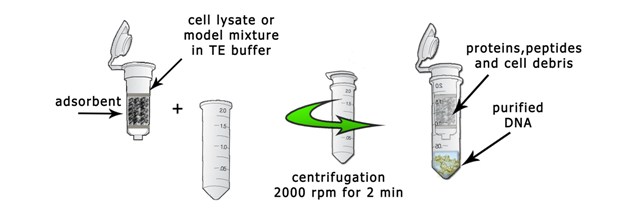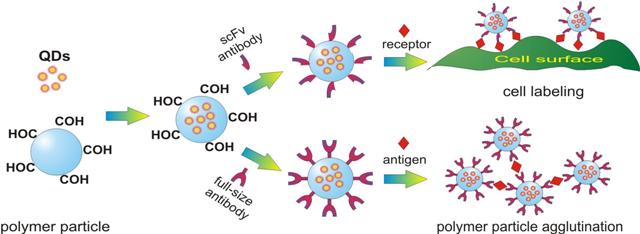Laboratory "Polymers for biology"
The Laboratory is engaged in development of composite adsorbents for bioseparation, model membranes based of monolayers and liposomes, immune dispersion diagnostic test-systems, biocompatible systems for enzyme and cell encapsulation and systems for hybridizational analysis.
Development of novel polymer and polymercontaining composite nanomaterials based on porous and non-porous matrices for bioseparation and bioanalysis, and biocompatible nanocoatings (including techniques for modification of the implant properties). The work in under supervision of Dr. D. Kapustin
- Development of direct synthesis of nanocomposites having detailed characterized morphology (Fig. 1), providing the localization of the polymerization process at the surface layers of matrices and introducing of additional functional groups (incliding bioligands) into obtaining materials;
- Development of the universal heterogeneous initiators of polymerization based on inorganic supports treated with ozone, for preparation of composite adsorbents modified with the polymers of different chemical nature;
- Design of biocatalists based on composite matrices modified with smart-polymers with immobilized bioligands (enzymes), which are effective both in the aqueous and in organic media;
- Development of universal adsorbents based on disperse carriers, capillaries, membranes, monoliters, silica chips, etc) modified with fluoropolymers and/or polyanilines, for one-step isolation and purification of biopolymers (nucleic acids, proteins, peptides) (Fig. 1). The obtained materials are perspective for elaboration of kits and protocols providing effective diagnostics of human pathogens, in particular, using PCR, and they also effective as supports for mass-spectrometry.
It is proved that the developed composites are useful not only for selective separation of mixtures of biomacromolecules (nucleic acids and proteins), but also effectively interact with complex supramolecular structures, such as viral particles (in particular, with RNA-containing shell viruses, with influenza virus B/Colorado/06/2017 similar to the virus B/Victoria/2/87. The decrease in the virus titer in virus-containing samples after passing through bioseparating elements with the developed composites was, on average, 2-3.5 lg TCD50/ml. In most experiments, the virus particles were completely retained.
The group cooperates with the research departments of the Institute, as well as with the Federal Center for Epidemiology and Microbiology named by N. F. Gamaleya of the Ministry of Health of the Russian Federation, with NPP "Technofilter" (Vladimir) and with a number of other institutes and companies.

Fig. 1. One-step biopolymers isolation.
The research of the group of Dr. A. Generalova is aimed at developing methods for producing polymer microspheres to solve various bioanalytical problems. In particular, recently A.N. Generalova and her colleagues developed:
- Elaboration of synthesis methods of colored and fluorescent polyacrolein and copolymer microspheres to obtain new bioanalitical reagnets for nigh-sensitive express-analysis of proteins, haptens and nucleic acids;
- Preparation of composite copolymer microspheres containing the fluorescent CdSe/ZnS nanocrystals close to surface. Such morphology makes it possible to register the fluorescence changing due to insignificant changing of environment, such as pH, ionic strength, temperature, etc, and use them as optical sensors (Fig.2).

Fig. 4. Inclusion of fluorescent CdSe / ZnS nanocrystals in polymer microspheres and their application in bioassay.
A decision to organize Polymers for biology laboratory was made in 1979 as a result of several discussions of Prof. V.P. Zubov and the director of the Institute of Chemistry of the Natural Compounds academician Yu.A. Ovchinnikov at symposiums and conferences. During these meetings they discussed an important role of chemistry of materials for the development of biology and medicine, a strong dependence of this scientific field on imported reagents and materials as well as a lack of specific departments for developing new materials for biology and biotechnology in our country.
The necessity to have high-purified concentrated samples of biologically active substances, in particular, biopolymers (such as nucleic acids and proteins) resulted in development of a number of effective sorption composite materials (adsorbents) combining the superior mechanical merits of solid insoluble matrix with unique sorption properties of polymer modifiers (primarily fluoropolymers and polyanilines). As it known, the most synthetic polymer materials are not suitable for use as “good” adsorbents due to certain properties (e.g. swelling ability, softness, low solubility or contrariwise, instability). Therefore, from practical point of view, use of polymer modifiers to obtain the composite materials seems to be an optimal way.
- A number of conditions were considered when technologies of such adsorbents preparation were developed.
- First, to provide defect-free morphology of obtained materials the principal of localization of polymerization process at surface layers of the support was adapted. For this purpose several approaches were developed to provide an activation of the carrier surface via different physical-chemical methods including radiolysis of the silica support surface, modification of the carrier surface with low-molecular or high-molecular agents, activation of the surface with ozone, usage of microwave or ultrasound treatment, etc.
- Consequently, high-effective biocompatible (i.e. excluding an irreversible denaturation of biopolymers) chromatographic materials were obtained. These materials were characterized with chemical stability, low non-specific sorption, high selectivity under biopolymers separation conditions. The examples of such developed in the laboratory materials are adsorbents based on porous silica modified with polytetrafluoroethylene, polytrifluorostyrene, poly-p-nitrophenylacryate, polyaniline and their derivatives.
- Secondly, the modern trends to miniaturization, robotization and reduction of time expenditures in the analytical tests as well as in the realization of preparative tasks, have required to develop simpler and cheaper (as compared to traditional column chromatographic systems and devices for solid-phase extraction) instruments for bioseparation and sample-preparation. Therefore, effective protocols of isolation and purification of biopolymers based on use of compact cartridges containing 60 – 100 mg of adsorbent were developed. Unique sorption properties of polymer modifiers in a content of the developed composites allowed to realizing of the conception based on one-step separation of nucleic acids and proteins. In this case, nucleic acid passes through the cartridge in excluded volume, but proteins, peptides and concomitant impurities are retained by the adsorbent. Moreother, the same sorption material can be used to separate the components of the retained protein fraction, if necessary.
- The examples of practical use of this principal are protocols of DNA isolation from the lysates of bacterial cultures, plant tissues, blood, etc. The obtained purified samples of DNA are suitable for direct use in PCR-analysis. The most effective materials for this aim are adsorbents based on porous silica and synthetic membranes modified with polyaniline and copolymers of aniline with 3-aminobenzoic acid. Such materials were successfully used for express sample-preparation followed by PCR-diagnostic of hepatitis C virus, as well as a number of bacterial and fungal urogenital infections.
- The functional properties of the described materials make them perspective for use in automated bioseparation systems both in the genomic and in the proteomic areas. However, these applications do not limit the fields of use of developed materials. Introducing of the additional functional groups into polyaniline modifiers provides to obtain new effective biocompatible materials, for example, the supports for bioanalytical application. New effective bioanalytical system based on silica support for mass-spectrometry was developed and patented (jointly with Royal Philips Electronics). The system exploits the ability of polyaniline-containing coating to separate the proteins (peptides) depending on pI value of individual component, as well as its ability to accumulate the laser energy.
- Developed methods were successfully used to obtain effective biocatalists based on silica modified with thermal-sensitive copolymer of N-vinylcaprolactame with 2-hydroxiethylmetacrylate. Lypase from Pseudomonas fluorescence was immobilized on the surface of obtained polymer-coated material. Thus obtained biocatalyst demonstrated higher enzymatic activity as compared to native lipase samples. Enzymatic activity in this case was kept both in aqueous and organic media.
- Introducing of the additional functionality to fluoropolymers also widens the fields of them applications. Use of partially fluorinated polymers to modify the supports provides not only improvement of their wettability, but also makes it possible to immobilize different bioligands. Method of preparation of stable fluoropolymer-containing support for solid-phase synthesis of oligonucleotides was developed in the laboratory. This method is based on preliminary modification of porous silica with fluoropolymer having active ester groups. After specific chemical modification using nucleozide, the obtained stable material was successfully used as a support for solid-phase synthesis of oligonucleotides.
- A versatility of fluoropolymer- and polyaniline-modified composite materials appears not only in wideness of their use for resolution of different chromatographic and diagnostic tasks, but also from technological point of view, so as the features of their chemical structure and properties allow to preparation of the composites effectively combining the properties of both polymer modifiers in the same material. To confirm the above, one can exemplify new technique developed in the laboratory “Polymers for biology”. The technique is based on use of silica matrices treated with ozone, which thus posturize the multi-purpose heterogenic initiators capable effectively initiate polymerization of such chemically different compounds as fluoropolymers and aniline.
Advantages of use of the composite materials with nanostructural elements also were realized in producing of bioanalytical systems based on polymer particles containing various (fluorescent, chromophoric) labels. The methods of preparation of dispersions containing polymer particles based on polyacrolein were used to produce a number of labeled bioanalytical reagents for latex-agglutination reaction performing to determine different analytes, such as diphtherin, ferritin, herbicides (2,4-D, atrazine, simazine), antibodies to lipopolysaccarides containing in the cytoderm of opportunistic pathogenic bacteria, thyroglobulin, thyroid body peroxidase, antibodies to mycobacteria of tuberculosis, etc.The work was carried out together with a wide range of scientific organizations (Mechnikov Research Institute of Vaccines and Sera, Russian Academy of Medical Sciences; Research and development center “Medical immunology”; Helmholtz Research Institute of Eye Diseases, etc).
- Recently semiconductive nanocrystals CdSe/ZnS (so called quantum dots – QDs) attract attention as perspective fluorophores. A panel of colloidal-stable polymer fluorescent particles of different diameter (0.15 – 0.52 mkm) was prepared by introducing of QDs into preliminary synthesized particles based on copolymers of acrolein with styrene. The obtained particles conjugated with monoclonal antibodies to Yersinia pestis antigen, and then the particles were used in reaction of passive agglutination both in the tests using glass slides (express-analysis) and in the simplest and most sensitive semiquantitative immunoanalytical variant using plates.
- An example of conjugates of fluorescent polymer particle with antibodies 4D5scFv demonstrates the possibility to in vitro label specifically the receptor HER2/neu at the membrane surface in the cells of human ovarian adenocarcinoma SKOV-3. The work was carried out in collaboration with the laboratories of Molecular biophysics and Molecular immunology of IBCh RAS.
- A number of international and Russian patents were registered, in which the most of above developments (in particular, fluoropolymer- and polyaniline-containing adsorbents for one-step DNA isolation, bioseparating elements for sample-preparation in PCR-analysis, silica chips modified with copolymers of aniline for SELDI-TOF-MS analysis, etc) were described.
| Fullname | Position | Contacts |
|---|---|---|
| Alla Generalova, D.Sc | Head of lab., pr. r. f. | |
| Alla Generalova, D.Sc | Head of lab., pr. r. f. | |
| Zubov V.P., Prof., D.Sc | pr. r. f. | |
| Dmitry Kapustin, D.Sc | s. r. f. | |
| Elena Yagudaeva, Ph.D. | s. r. f. | |
| Anna Prostyakova, Ph.D. | s. r. f. | |
| Aleksandr Vikhrov, Ph.D. | r. f. | |
| Zhigis L.S., Ph.D. | r. f. | |
| Polina Demina, Ph.D. | j. r. f. | |
| Anastasia Sochilina, Ph.D. | j. r. f. | |
| Razguljaeva O.A. | eng. | |
Previously worked here | ||
| Elena Markvicheva, D.Sc | ||
| Khajdukov E.V. | ||
| Roman Akasov, Ph.D. | ||
| Oksana Selina, Ph.D. | ||
| Svetlana Sizova, Ph.D. | ||
| Zueva V.S., Ph.D. | ||
| Myasoedov M.S. | ||
| Zaytseva-Zotova D.S., Ph.D. | ||
| Maria Drozdova | ||
| Anastasia Gileva | ||
| Anna Khovankina | ||
| Morozova S.A. | ||
 Loading...
Loading...Scientific projects
 Loading...
Loading...Alla Generalova
Russia, Moscow, Ul. Miklukho-Maklaya 16/10 — On the map
